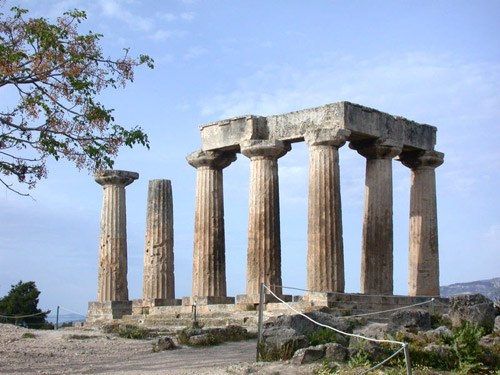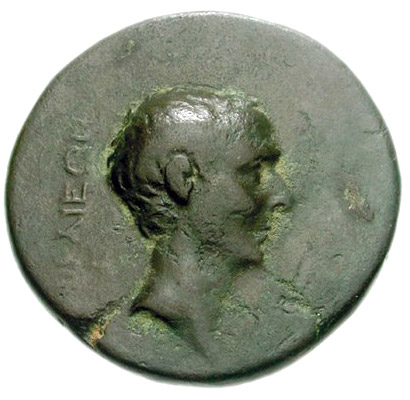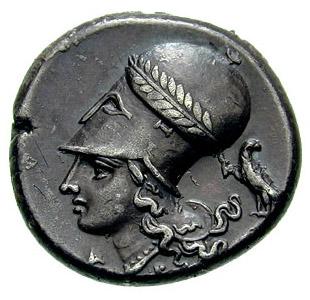The General Abroad: Caesar's Portrait in the Provinces
The Romans did not have a history of representing living men on their coins, unlike the Hellenistic kingdoms. But prior to Caesar's portrait coins a Greek state had depicted Titus Quinctius Flamininus on a special issue of gold staters. This is the first example of a living Roman on a coin. It is unclear whether Flamininus himself or the Greek states authorised the types but they were undoubtedly intended to celebrate Flamininus' victory over Phillip V of Macedon in 197 BC (Boyce 1962).
Caesar's portrait appears during his lifetime on the issues of three mints located in the provinces. The first appeared in Nicaea around 47/6 BC (RPC 2026). The obverse inscription reads NIKAIEΩN (Nicaea) and depicted the bare head of Caesar. The reverse inscription read EΠI ΓAIOY OYIBIOY ΠAN∑A (Magistrate Gaius Vibius Pansa) with Nike advancing right with a palm branch and wreath below. The issue was minted by C. Vibius Pansa, the proconsul at the time, who was also a supporter of Caesar.
The second issue originated in Lampsacus around 45 BC (RPC 2268-2269). The obverse reads C G I L (a possible abbreviation of the name Colonia Gemella Iulia Lampsacus) and has a laureate head of Caesar. Its reverse legend reads Q LVCRETI(O) L PONTI(O) II VIR M TVRIO LEG (Q. Lucretius and L. Pontius duoviri and M. Turius, legate) or Q LUCRETI(VS) L PONTI(VS) II VIR COL DED PR (Q. Lucretius and L. Pontius duoviri , the colony is first founded) and shows a priest ploughing with oxen. This scene is traditional in celebrating the foundation of new colonies as it represents the priest ploughing the symbolic boarders of the new town. It suggests that Caesar may have played a role in the foundation of the colony.

The final provincial coin which may have been minted during Caesar's lifetime is from Corinth and was minted around 44 to 43 BC (RPC 1116). The obverse legend read LAVS IVLI CORINT (referring to the city of Corinth) with a laureate head of Caesar. The reverse reads L CERTO AEFICIO C IVLI(O) IIVIR (L. Certus Aeficius and C. Iulius, duoviri) with Bellerophon wearing a petasus and mounted on a flying Pegasus. This was a traditional Corinthian image. Corinth was destroyed in 146 BC and was not re-founded until 44 BC by Caesar as the Laus Iulia Corinthiensis. This issue most likely celebrated the re-founding of Corinth by Caesar; Pegasus was a traditional image that appeared on the earlier coins of the independent Greek state of Corinth.
It is unclear how the image of Caesar was transmitted to these provincial cities. The portraits can be recognised as Caesar, but are lacking in detail. It is known that there were many statues of Caesar commissioned in Greece and the east during his lifetime (Raubitschek 1954) and these would have allowed the people living in these provinces to become familiar with his image.


